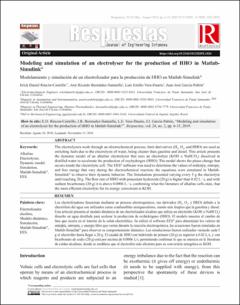Modeling and simulation of an electrolyser for the production of HHO in Matlab- Simulink
Modelamiento y simulación de un electrolizador para la producción de HHO en Matlab-Simulink
Artículo de revista
2019-05-01
Colombia
The electrolyzers work through an electrochemical process, their derivatives (H2, O2, and HHO) are used as enriching fuels due to the electrolysis of water, being cleaner than gasoline and diesel. This article presents the dynamic model of an alkaline electrolyzer that uses an electrolyte (KOH o NaHCO3) dissolved in distilled water to accelerate the production of oxyhydrogen (HHO). The model shows the phase change that occurs inside the electrolytic cell. The EES® software was used to determine the values of enthalpy, entropy, and free energy that vary during the electrochemical reaction; the equations were simulated in Matlab-Simulink® to observe their dynamic behavior. The Simulations presented varying every 5 g the electrolyte until reaching 20 g. The flow rate of HHO with potassium hydroxide (20 g) is higher than 0.02 L / s, and with sodium bicarbonate (20 g) it is above 0.0006 L / s, confirming what the literature of alkaline cells state, that the most efficient electrolyte for its energy conversion is KOH Los electrolizadores funcionan mediante un proceso electroquímico, sus derivados (H2, O2, y HHO) debido a la electrólisis del agua son utilizados como combustibles enriquecedores, siendo más limpios que la gasolina y diesel. Este artículo presenta el modelo dinámico de un electrolizador alcalino que utiliza un electrolito (KOH o NaHCO3) disuelto en agua destilada para acelerar la producción de oxihidrógeno (HHO). El modelo muestra el cambio de fase que ocurre en el interior de la celda electrolítica. Se utilizó el software EES® para determinar los valores de entalpía, entropía, y energía libre que varían durante la reacción electroquímica, las ecuaciones fueron simuladas en Matlab-Simulink® para observar su comportamiento dinámico. Las simulaciones fueron realizadas variando cada 5 g el electrolito hasta llegar a 20 g. El caudal de HHO con hidróxido de potasio (20 g) es superior a 0.02 L/s, y con bicarbonato de sodio (20 g) está por encima de 0.0006 L/s, permitiendo confirmar lo que se enuncia en la literatura de celdas alcalinas, donde se establece que el electrolito más eficiente para su conversión energética es KOH.
Descripción:
Modeling and simulation of an electrolyser for the production of HHO in Matlab- Simulink.pdf
Título: Modeling and simulation of an electrolyser for the production of HHO in Matlab- Simulink.pdf
Tamaño: 14.43Mb
 PDF
PDF
 LEER EN FLIP
LEER EN FLIP
Título: Modeling and simulation of an electrolyser for the production of HHO in Matlab- Simulink.pdf
Tamaño: 14.43Mb
 PDF
PDF
 LEER EN FLIP
LEER EN FLIP

















